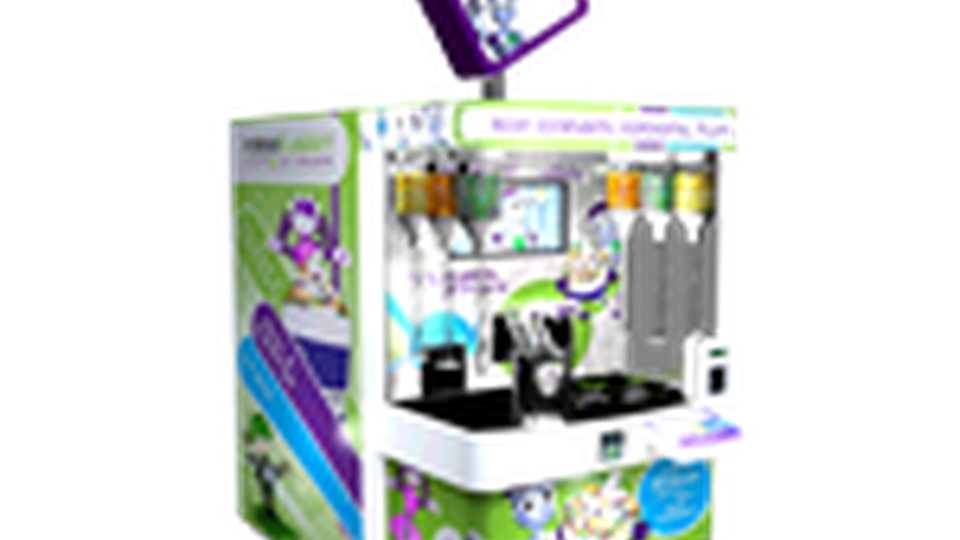Article
Robot-powered kiosks seek frozen yogurt domination
Robofusion's CEO believes his kiosk concept will put a dent in the fro-yo industry.

February 26, 2014 by Natalie Gagliordi — Editor of KioskMarketplace.com, Networld Media Group
The market for self-service and automation has grown increasingly diverse. Vending machines have evolved into mini-markets, kiosks have become dynamic points of consumer engagement and screens are always interactive.
The cause of that diversity and market growth is two-fold. On the retail side, kiosks and automated retail stations provide a business the ability to do more with less — the venerable "Holy Grail" of today's economy. For consumers, interactive technology is expected, accepted and welcomed.
For Allan Jones, the CEO of the frozen yogurt kiosk concept Robofusion, the clear growth trajectory and business potential for the automated retail market was the impetus for him to quit his job at a chemical company and pursue a venture in robotically-served sweets.
Robofusion's kiosks dispense yogurt and ice cream with the help of a robotic arm that fills the cups, adds the toppings and delivers the treat to the customer through a revolving platform. A touchscreen user interface allows for selection and customization of the product, which sells for between $3 and $6, depending on the size. There are 37 Robofusion kiosks deployed globally, Jones said.
In the interview below, Jones explains the complexities of the business, why he chose frozen yogurt and how he's planning a robot invasion in a convenience store near you:
Q: How did you decide to go with frozen yogurt as a kiosk concept?
A: Doing something truly disruptive seems to be every boy and girl's dream. This is an incredibly disruptive concept.
Delivering frozen yogurt from a fro-yo store is a very expensive endeavor with a very large overhead to cover. My background is as a trained scientist and managing product development globally. My co-founder, James Wolf, just saw an opportunity to deliver frozen yogurt in an automated way in a tiny footprint with about one-tenth of the energy consumption of a typical fro-yo store.
Q: How complex was/is the kiosk manufacturing process? Are there many different vendors you have to go through to piece together the robotics, software and touchscreen user interface? Or is it all done in-house?
A: The engineering/design was much more complex than the manufacturing process. We spent a few years and a few million (dollars) bringing the concept from idea to a perfected (well, almost) kiosk.
Yes, we have a lot of vendors. We purchase the robot/controller. We purchase the frozen yogurt delivery device (engineered by us, by built by vendor). All the software was developed in-house as well as all the graphics/video and GUI.
Q: Can you explain how you work with frozen yogurt providers?
A: There are a lot of providers of frozen yogurt mix and a lot of providers of toppings, etc. We don't produce them. We use these vendors in our company-owned kiosks and licensees use them in the kiosks they own.
Q: How is the overall revenue structure built? Who earns money and how?
A: Two ways generally.
We (or our licensees) typically place these with partners (waterpark resort, science museums, etc.). The venue runs the "store." They purchase the COGS, clean the kiosk daily/weekly, etc.
The other way we operate is similar to Redbox in this one way. We daily stock, clean and take complete care of the kiosk. Then we pay rent via set or revenue-share with the entity. We are doing this is high schools now very effectively.
Q: What locations seem to be most profitable for the kiosk? Is there more interest overseas than in the U.S.?
more interest overseas than in the U.S.?
A: There are many profitable venues. Science centers, international malls, now we are growing with schools. There is tremendous interest in both the U.S. and internationally. We are currently in Singapore, Brazil, Turkey, Australia, Dubai, and the UAE and are shipping kiosks currently to Saudi Arabia and Mexico. We are working deals in many other countries.
Q: Why go after the c-store space?
A: C-stores are moving more and more to "fresh." Most of the newer/better c-store concepts aren't content with the same-old pre-packaged stuff filled with all sorts of preservatives. You see them moving to made-to-order, better coffees, etc.
Frozen yogurt is a next natural and we're already starting to see it. That being said, we believe our kiosks, from cleanliness, simplicity, floor space and economics, are simply the no-brainer solution. You'll start seeing our kiosks populate many of the c-stores this year.
Q: Are the kiosks operated by the c-store or a separate franchisee-type operator?
A: There are options, but it's mostly dependent on the philosophy of particular c-store. We are exploring multiple arrangements with multiple c-stores and franchise companies.
Q: Who/what do you consider your competition?
A: It's really venue-dependent. In a c-store, our competition could be another fro-yo franchise that would want the same c-store and put in a traditional DIY set up. Also, pre-packaging frozen things in a c-store could be considered competition, but our customers are usually looking for something that is non-fat, healthier and fresh.
For a high school, well, our main competition is probably vending machines ... but they are disappearing or changing dramatically due to the products they sell.
If you look at that a different way, and use the Redbox analogy, certainly Blockbuster was a competitor. But that went away pretty quickly given the tremendous advantage of the delivery system of the Redbox.
We believe there will always be a place for traditional fro-yo stores. We do believe there will be massive roll-up and realignment and the weaker stores will fail. And as more people buy their fro-yo from one of our kiosks at work, school, c-store, or whatever, they'll most likely buy a lot less of it in traditional environments.
Q: What is your opinion on the rising popularity of foodservice kiosks, aka smart vending machines? Do you forecast this type of retail to continue to gain momentum?
A: This is a no-brainer and will certainly to grow ... and fast. The younger population (and a lot of us that aren't as young as we used to be) simply greatly prefer pushing buttons to talking to someone. Most people love the simplicity of good kiosks and the consistency of the experience. And fresh products, delivered in an economical way, will continue to grow rapidly.
We have just begun to really hit our stride and we love developing this concept. Very few teams in this lifetime get a chance to put a dent in the universe ... and that's what we're doing.










